Showcase of students work
See examples of our students work in English Language and Literature.
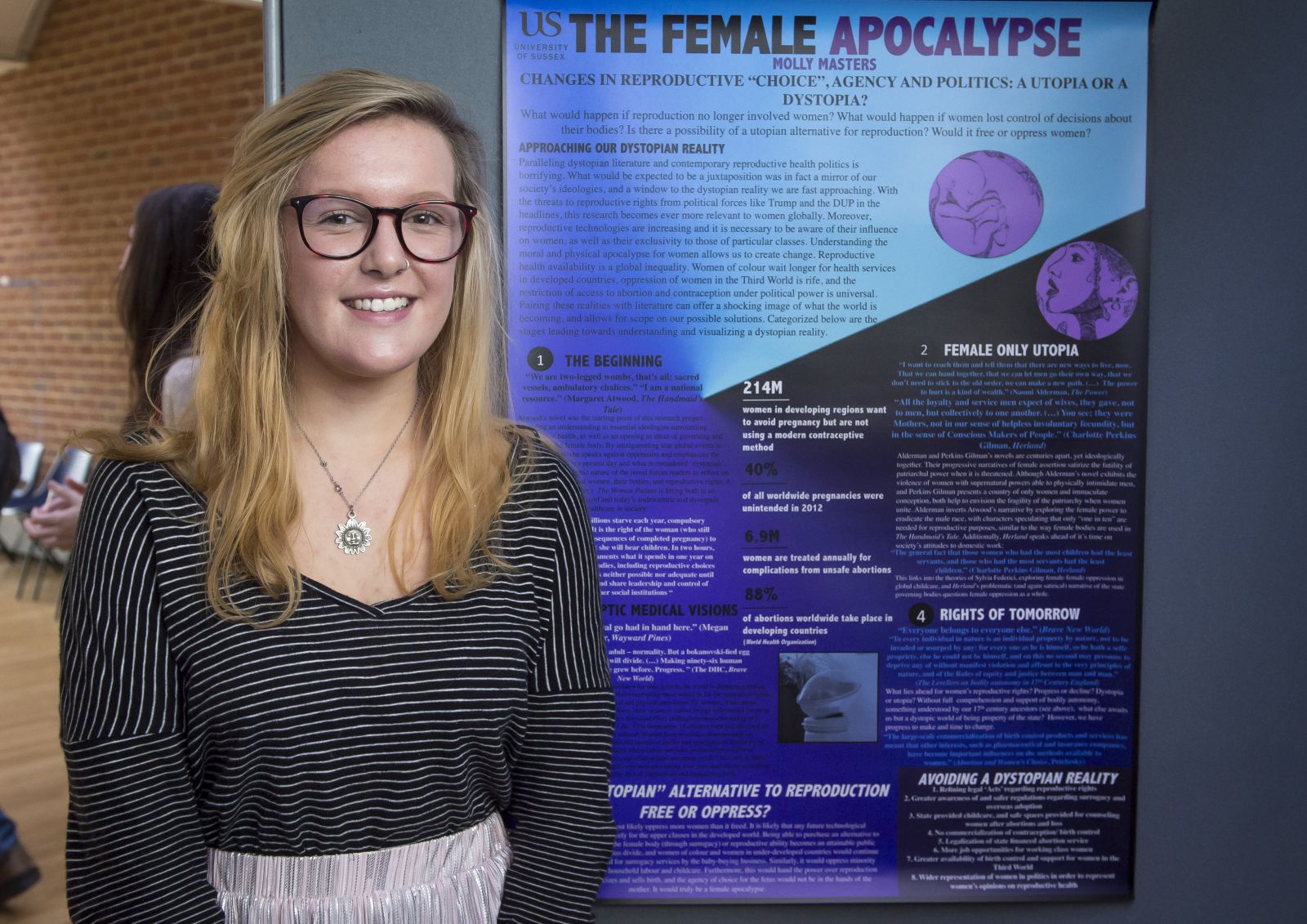
Student work
In our 'The Art of Short Fiction' module students are encouraged to respond to texts each week by writing their own fictions and reflecting on them in a logbook. Emily Salamon-Andrew created a story called "Our Bathroom" which tracks grief and the bath is used as a vehicle to travel through memory. Emily produced a conventional version of this story as well as a more experimental or playful version in which the text becomes fragmented and the page layout begins to mirror the movement of water.
Some of our students have taken part in the University of Sussex Junior Research Associate (JRA) and Sussex Undergraduate Research Associate (SURA) schemes, which aim to develop future research leaders.
They reward academic excellence by supporting high-achieving undergraduates to work alongside Sussex's top research faculty during the summer holiday. To find out more about these programmes, see our research pages.
Ten English students were awarded these paid, eight-week long fellowships.
English student, Molly Masters (pictured above). exhibited her research exploring what would happen if reproduction no longer involved women.
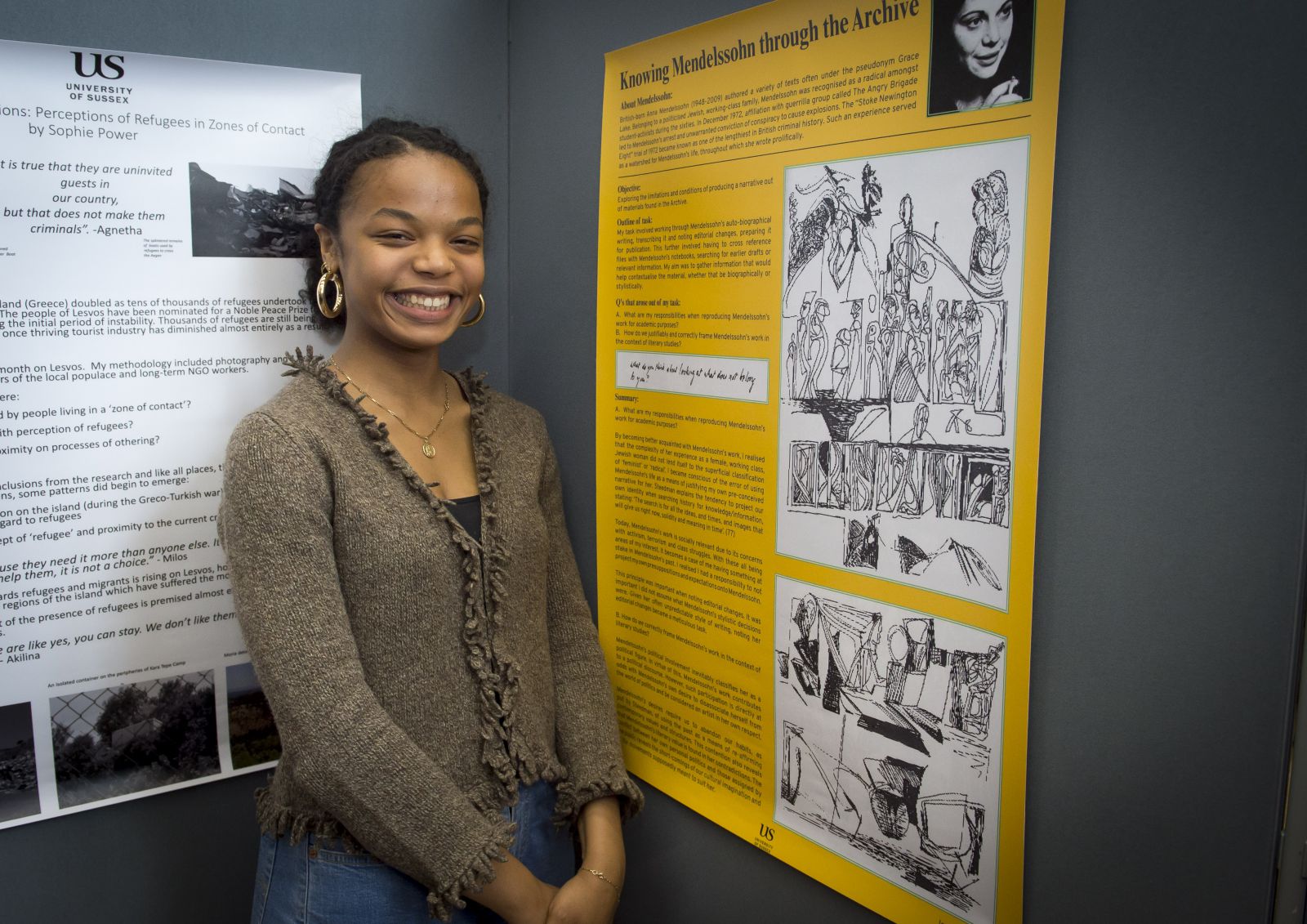
Isabelle Clarke (pictured above) exhibited her research about poet Anna Mendelssohn. We hold Mendelssohn's archive at The Keep, near the Sussex campus.
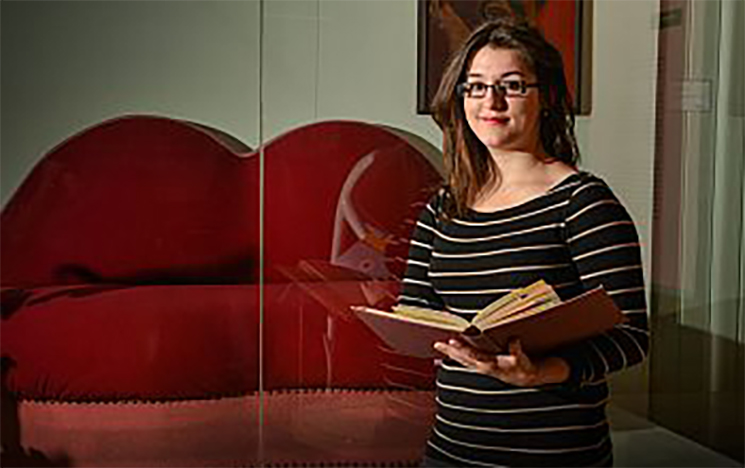
The Sussex surrealist Edward James worked with the likes of Salvador Dalí to produce some of the movement’s most iconic works – and his story comes under the spotlight in English student Claudia Cockrell’s (pictured above) JRA project.
Claudia developed a taste for the surreal while studying English modernism on her undergraduate degree course. Discussions with her tutors led her to the Edwardian aesthete and eccentric Edward James and a place on the JRA programme.
Claudia carried out research at Brighton Museum and Art Gallery (custodians of the famous Mae West Lips sofa by Dalí) and West Dean in Sussex, the former home of James.
Claudia said: “Edward James is more well-known as an art collector and patron to surrealists Dalí and Magritte than as a writer. He was the model for Magritte's Not to be Reproduced and The Pleasure Principle and collaborated with Dalí to produce The Lobster Telephone and Mae West's Lips, which are all famous surrealist art works.
“However, further reading of Edward James's poetry reveals that, while much of it has content that is surreal, it tends to be presented in traditional ways. One might assume that form would follow content, but as we see in the case of Edward James, this is not always the case. What I hope to explore through the works of Edward James, in comparison to other surrealist works, is the disparity between content and form in his work, with a view to ascertaining the significance of Edward James as a surreal poet.
“I read about the JRA scheme and it sounded fascinating so I decided to apply. The opportunity to gain experience working in a research-intensive atmosphere and building on my academic portfolio was something not to be missed. To also have it funded was the icing on the cake.
“Finding the sources for an unknown figure like Edward James has proved a great challenge but I have enjoyed it. I attended a JRA meet up, where I heard that one of the psychology JRAs from a few years ago is now leader in her field, as a result of her JRA research. I really do recommend this opportunity to everyone who has an ambition to become an academic.
“Working as a JRA teaches you how to work independently – a valuable lesson for anyone who wants to work in academia as it will help you with experiencing how research works, step by step; right from conceiving a proposal to researching it to presenting it."
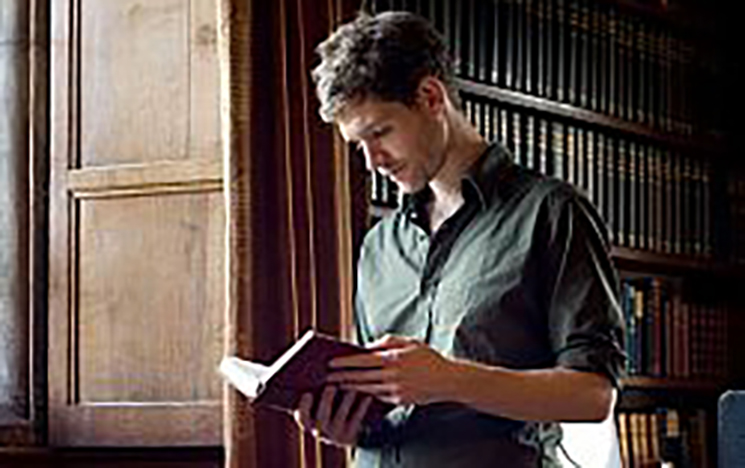
University-funded research by Sussex undergraduate Nick Skidmore (pictured above) into Rudyard Kipling's correspondence went on display at Bateman’s, the author’s Sussex home.
The final-year English literature student undertook the research, supervised by Senior Lecturer in English Dr Alastair Davies, as part of the Junior Research Associate bursary scheme.
Nick visited Bateman’s, a splendid Jacobean house, and spent time in Kipling’s study, which remains as a shrine to the great writer of Kim, The Jungle Book and poems such as If.
Nick says: “Bateman’s gives the public a wonderful opportunity to explore Kipling’s home and delve into the heavily guarded private life of one of our great writers, a man whose work brought so much joy, yet whose life was tinged with sadness. It’s a considerable honour to have the opportunity to display my research there.”
Nick chose to study the writer Rudyard Kipling and his complex relationship with the British. Empire and the First World War, making use of the University archive of Kipling papers, housed in the Library’s Special Collections division.
Aside from his moral and political convictions, Kipling also had to come to terms with the death of his only son John, who was killed in action in the Battle of Loos in 1915.
The collection includes Kipling’s correspondence with his son, including John’s last letter from the Front. The grief-stricken Kiplings spent the rest of the war trying to find out what had happened to their son who, like millions of others, disappeared on the battlefields of France and Belgium.
Nick says: “It is Kipling’s poem The Children that is, perhaps, the most haunting of Kipling’s verses about the Great War. It does not linger on politics, or vendetta but rather demonstrates the tortuous workings of the imagination amongst the echoes of the refrain ’But who shall return us our children?” It is here we find Kipling at his most honest.”
To learn more about the Kipling Papers at the University of Sussex, see the Sussex Special Collections.
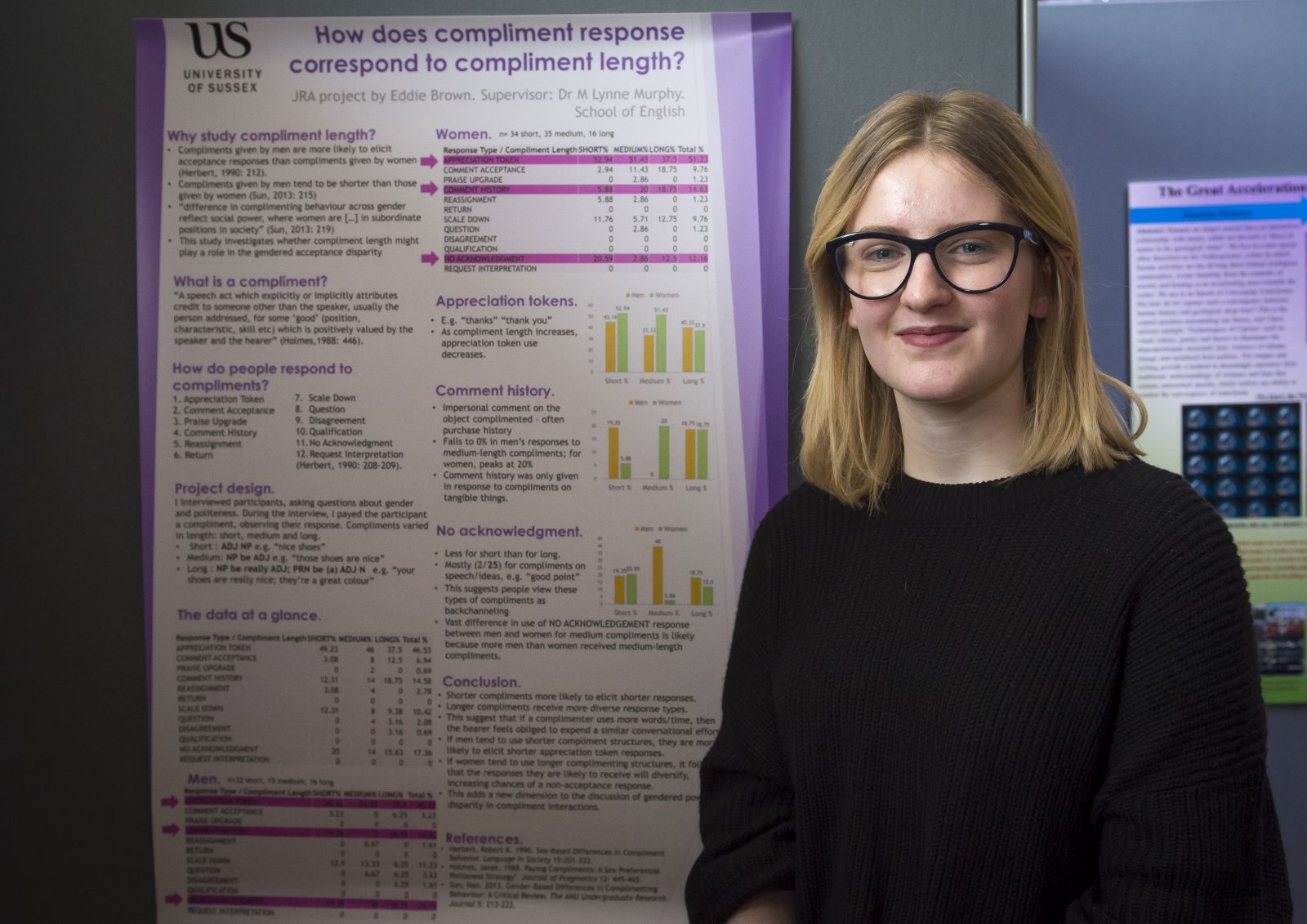
More student work
- Sarah Fitzgerald - Developing a parts-of-speech tagging system for Cameroon Pidgin English
Cameroon Pidgin English (CPE) is a poorly-documented creole variety spoken by up to 50% of Cameroon's 22,000,000 population. It is a stigmatised, unwritten language. The absence of written texts in CPE has until recently prevented the creation of a digital corpus, making quantitative empirical study of the structure of this language difficult. Dr Melanie Green and her colleagues have now collected and transcribed 120,000 words of spoken CPE.
Sarah proposed to develop a system for labelling the words in this pilot digital corpus for their parts-of-speech (POS), or grammatical category (noun, verb, adjective etc.), a process known as 'tagging'. POS tags play two important roles in digital corpora: (i) enabling searches for frequently occurring grammatical patterns; and (ii) distinguishing between words with more than one meaning or function. For example, the CPE word de can be a definite article ('the'), a noun ('day'), a pronoun ('they'), or a locative adverb ('there'). This multifunctionality is a common feature of creole languages, which have relatively small vocabularies with which to express the richness of meaning characteristic of human language. The tagging of these multifunctional expressions cannot be done automatically.
As a creole, CPE contains many examples of such words, making a tagging system crucial for accurate description of the language. Sarah will also develop a set of rules for these ambiguous cases, allowing future CPE POS tagging to be carried out consistently and rapidly, as the digital corpus is expanded.
Sara has now completed her JRA project and has written about how it developed her knowledge and skills and provided a new opportunity for her. Find out more.
- Jamila Prowse - The Right Stuff: Female Astronauts in Science Fiction
Of the 535 astronauts who have entered into space, only 58 have been women; those women who have been involved in space travel have received little or no recognition for their contributions. Jamila proposed to analyse how the representation of female astronauts changed during the Cold War period, a time when space exploration was at the forefront of political discourse. Jamila argued that the depictions of female astronauts in science fiction don't simply acknowledge the presence of women involved with space travel, they imagine an ideal in which they are undoubtedly active participants in the field of scientific discovery. Extending the work of Joanna Russ, who explored feminism in science fiction, Jamila will detail how a recent revival of interest towards women in space may have been established by such literature.
Jamila’s research focused on depictions of female astronauts in two works of literature from the Cold War era. A comparative study of Solaris by Lem Stanislaw (1961) and Amanda and the Eleven Million Mile High Dancer by Carol Hill (1993) allowed for an analysis that focuses on a distinct period in history for space travel. Building on Naomi Oreskes' analysis of heroism in scientific thought, Jamila analysed the gender politics of narratives of space travel and their attendant displays of nationalism. If eighteenth-century portrayals of prostitutes served to demand a place for women in the public sphere, fictions of space flight go further by portraying women as historical actors. The representation of female astronauts in science fiction is an example of a utopian narrative, with "utopia" referring to the imagining of a better world. The image has the potential to incite political change, not in reflecting social disparity, but in producing alternate realities.
- Matthew Rosen - Humphrey Jennings: Cinema and Surrealism, 1934-1950
Humphrey Jennings was a figure of considerable local and national significance. Humphrey Jennings has been described as 'the only real poet' of British cinema. The films that he made for the Ministry of Information during the Second World War contain some of the most enduring images of British wartime resilience, and include Fires Were Started, London Can Take It, and Listen to Britain. Though Jennings is best known for the films he produced during WWII on behalf of the Ministry of Information, he was also a member of the short-lived English Surrealist Group and the founder of Mass Observation.
Matthew’s project explored the marriage of two traditions in the work of Humphrey Jennings (1907-1950): early British documentary filmmaking and French Surrealism, two practices widely assumed to be Incompatible. Matthew undertook archival research to consider the formative effect that Jennings's engagement with Surrealism between 1934-37 had on the realistic documentary style for which he is known. With so much of Jennings and other English Surrealists' work archived locally, his project also emphasised Sussex's contribution to early twentieth century modernism, and the University's unique position in relation to that history. How did Jennings consolidate quintessentially British experiences of everyday life with the fantasies of Continental Surrealism? What drew so many Surrealists to the South East?
There are three local archives of importance: Farley Farm House, 'the home of English Surrealism', near Lewes; the collection of early British documentary films at Screen Archive South East at the University of Brighton; and the Mass Observation archives at the Keep.
As well as offering a timely reassessment of Jennings's work, this interdisciplinary project made an important contribution to the University of Sussex's distinct engagement with the local history of modernism. Matthew plans for a multimedial result for his Jenning research project: To produce an ambitious and engaging assessment of Jennings in the form of a poster, with a complementary essay; To exhibit a poster at The Keep, West Dean, and/or Farley Farm House; To present his findings at the British Conference of Undergraduate Research (BCUR); To submit his research for publication in an open-access undergraduate journal associated with the BCUR (Reinvention: an International Journal of Undergraduate Research). Matthew plans to continue with postgraduate research following his undergraduate degree.